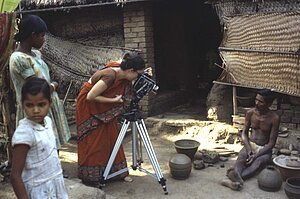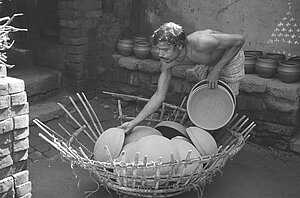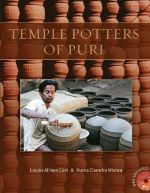The Project
Background of the Project
Louise Cort’s unexpected introduction to the earthenware pots produced by the Kumbhara Bishoi for the Jagannatha Temple occurred during her first brief visit to India in 1973, on the way back to the United States from a longer research session in Japan. Her itinerary was shaped by visits to the parents of various Indian and American friends from Cambridge, Massachusetts, where she was working at the Fogg Art Museum, Harvard University. These included the parents of a Bengali friend, Supratik Bose. Biswarup Bose was an artist and taught at Santiniketan (Visva-Bharati) University, West Bengal, as had his father, the renowned artist Nandalal Bose. Biswarup’s wife, Nivedita, who had also grown up in the bucolic university town of Santiniketan, was an accomplished batik artist and potter. Biswarup and Nivedita took Louise to Puri to show her where the family had customarily spent summer holidays. At their lodging they partook of a midday meal of mahaprasad, and all three were drawn to the distinctive forms of the red clay pots in which the food was served. The following morning, they went to the main potters’ village of Kumbharapada, on the ooutskirts of Puri, where they encountered Guna Bishoi and his father, who proudly described their hereditary roles as sevakas of the temple. The potters emphasized that each cooking pot could be used only once before its purity was exhausted; thus, there was an endless demand for new pots. This revelatory conversation left a deep impression. Guna would become a valuable informant for our joint research.
Just as Louise was completing her book on Shigaraki in 1979, a new grant program created by the Indo-US Subcommission on Education and Culture offered an opportunity for non-India specialists to conduct research in India. She applied successfully to do a research project in Puri. By chance, she met Cambridge-based anthropologist Frédérique Apffel-Marglin, who had completed research on the female singers and dancers (devadasis) associated with the Jagannatha Temple and published Wives of the God-King: The Rituals of the Devadasis of Puri (Oxford 1985), and who kindly offered an introduction to her research assistant—Purna Chandra Mishra. Louise wrote to Purna and they agreed to collaborate. By coincidence, Purna’s wife Sureswari, who taught Sanskrit at Puri Government Women’s College, had led her students in a project to encourage the opening of savings accounts in the potters’ community of Tikarapada, so Purna was known there already. He understood that the arrival of a lone foreign female researcher would create unease, so he explained to the potters that Louise was a friend who wanted to accompany him on his own research project. That explanation satisfied everyone and smoothed the way for congenial collaboration. Moreover, Purna, although a high-status Brahmin, was comfortable mixing and eating with every social level, thanks to his own temperament as well as his long and diverse experience with the Orissa Research Project. He became a valued advisor to everyone in the village, helping them with medical and financial problems and other daily difficulties. To the present day, he has maintained his close connection to the Tikarapada community, paying special attention to the annual enactment of Kurala Panchami.
Meetings with three South Asian cultural anthropologists with deep interests in the work of potters had special meaning for our work. Baidyanath Saraswati (1932–2013) and Nab Kishore Behura (1933–) co-wrote Pottery Techniques in Peasant India (Anthropological Survey of India, 1966) to record a sweeping view of variations in pottery technology in practice throughout India. Behura, who lived and taught in Bhubaneswar, went on to publish Peasant Potters of Orissa: A Sociological Study (New Delhi: Sterling, 1978). Haku Shah (1934–2019) based his life and work in Gujarat. His publication Rural Craftsmen and Their Work, with Eberhard Fischer (Ahmedabad: National Institute of Design, 1970), was of particular inspiration, as were conversations with him during visits to Ahmedabad.
Fieldwork
Our collaborative fieldwork centered on almost daily visits to the potters’ village of Tikarapada. We rode our bicycles through town, out past the Indradyumna tank and a grove of cashew trees, and into the village, passing the homes of a few farmers before coming to rest beneath a coconut palm on land belonging to the village headman and senior potter, Hadibandhu Bishoi. As we entered the village, we were already taking note of what people were doing that day. Our pattern was to greet Hadibandhu and another senior potter, Brundaban Bishoi, then make our rounds of various potters’ workshops. Depending on the day, we observed aspects of the production and firing processes followed by both men and women or discussed various matters of personal or community concern, notably the potters’ unending struggles with the temple cooks to control the prices for pots.
We observed many aspects of daily life as well as the annual season for clay digging and the preparations for annual festivals, notably Kurala Panchami. Before that event, which honored the potters’ occupation, they hurried to send all their finished orders to the temple kitchen and thoroughly clean and decorate their workshops, kilns, wheels, and tools. On the first morning of the festival, the Brahmin affiliated with the potters came to each workshop to conduct a puja. The potters then enjoyed a prescribed number of days of leisure before returning to work for another year.
We completed our daily visits by noon and returned to our respective homes. On most days we gathered again in the late afternoon at Louise’s seaside lodgings to discuss what we had seen and heard that day and to plan our ongoing threads of research. Once we got to know the potters well, we set up visits by various men and women to Louise’s lodgings for in-depth interviews that allowed us to capture their life stories. We also completed a form for each family of potters to record basic information about them.
The fieldwork benefited enormously from Purna’s curiosity and willingness to mix easily with people at all levels of society, in all caste groups. The potters were Shudras, and Purna as a Sasan Brahmin could have chosen to keep his distance. Instead, he comfortably accepted invitations to share food with the potters, earning their admiration, affection, and trust. His interest in their community went far beyond our research topics, and he became indispensable to them as a source of guidance and advice on all sorts of complicated matters. Moreover, he has continued this relationship to the present day. We gave copies of our book, Temple Potters of Puri, to all the potter households, and we donated funds for various community festivals and household celebrations, and for the crisis when the potters’ work vanished during the Covid-19 pandemic.
The Publication
Our study resulted in a jointly authored book, Temple Potters of Puri (Ahmedabad: Mapin, 2013). After settling in Washington, DC, Louise prepared the book, a process that was prolonged by demands of her regular work at the museum. There, however, she was fortunate to meet Bipin Shah, publisher of Mapin Publishing in Ahmedabad, known for the high quality of its publications on Indian arts and culture. He agreed to take on the publication project, putting no restrictions on length of text or number of illustrations.
In addition to color and black-and-white photographs, the book incorporated a DVD of our film about the potters’ working practices and annual celebration of Kurala Panchami. Smithsonian-affiliated graphic artist Daphne Shuttleworth prepared maps and line drawing. They were based on maps of Tikarapada and schematic drawings made at our request by Canadian architect Alan J. Short, who lived in Puri during our collaborative research.
Funding and Acknowledgements
A grant to Louise Allison Cort from the Indo-U.S. Subcommission on Education and Culture made possible the fieldwork in Puri from October 1979 to February 1981. The Anthropological Survey of India, Kolkata, sponsored her research in India.
Grants from the Social Science Research Council and the Smithsonian Institution Special Foreign Currency Program in 1984 enabled Cort and Mishra’s one-month research visit to the Archives of the South Asia Institute, University of Heidelberg.





